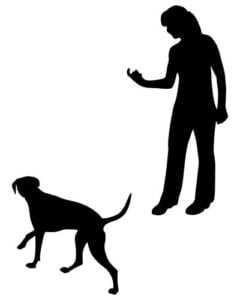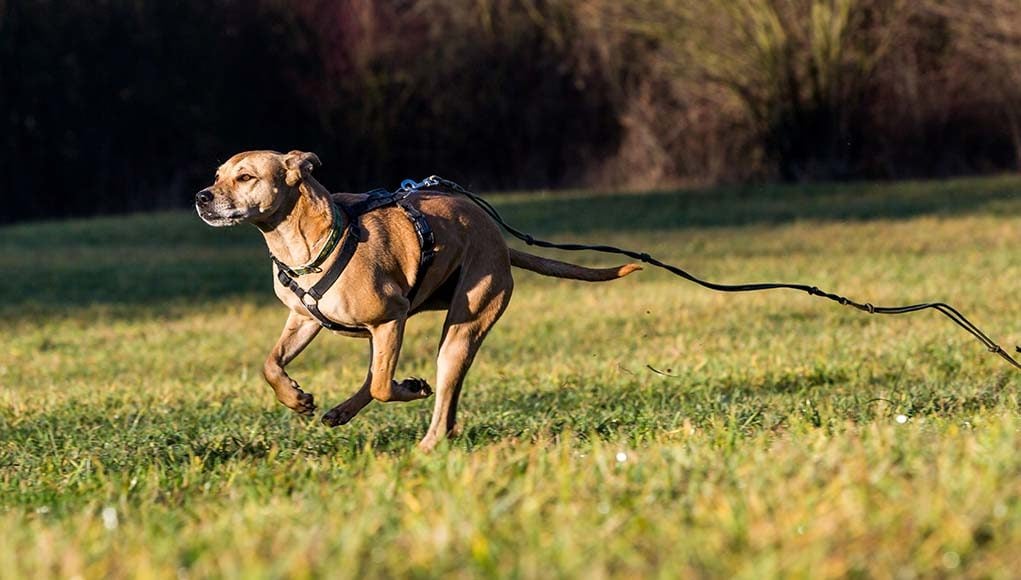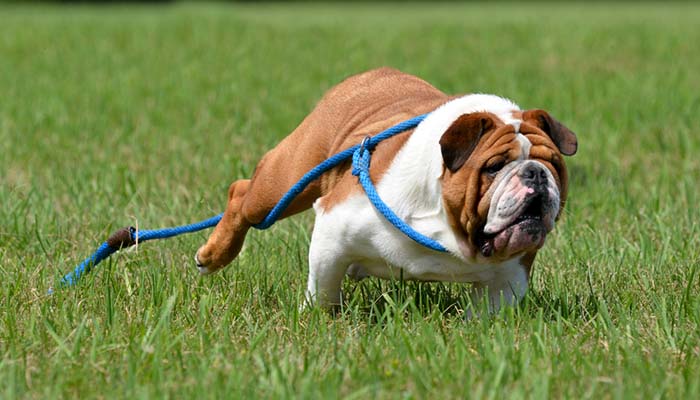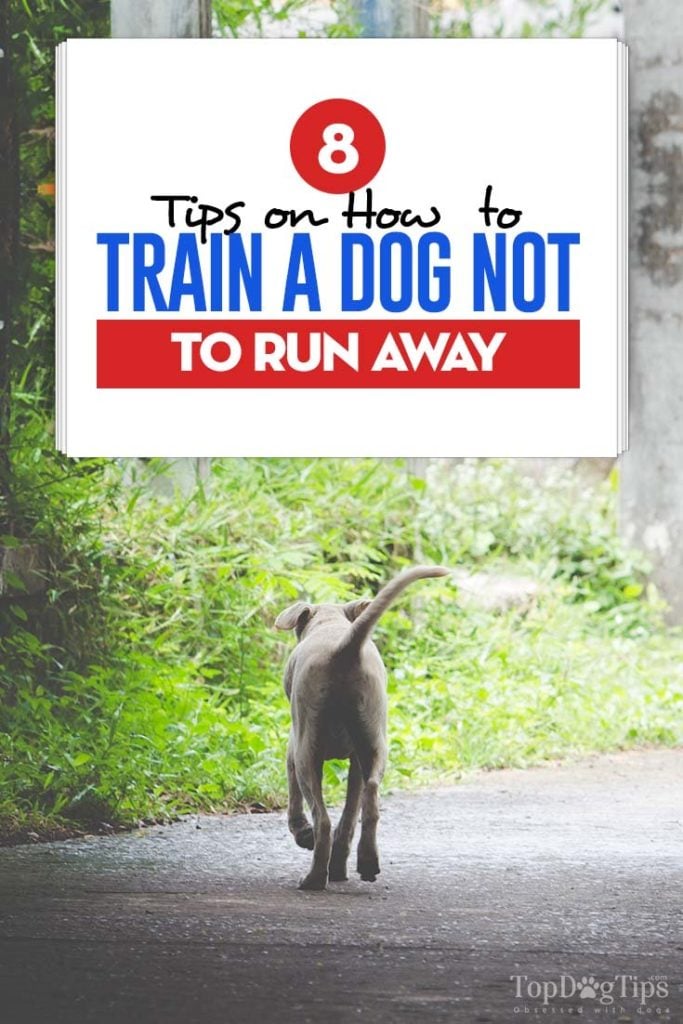Table of Contents
- Shock Collars vs Dog Training for Off-leash Dogs
- Why Do Dogs Run Away?
- How to Train a Dog Not to Run Away
- 1. Set Them Up for Success
- 2. Use a Clicker (and a Whistle)
- 3. Run Backwards or Zig-Zag (Away From the Dog)
- 4. Use an Excited and Happy Tone of Voice
- 5. Keep the Training Light and Fun
- 6. Always End on a High Note
- 7. Be Consistent with Rewards
- 8. Pack Irresistible Treats
- READ NEXT: 10 More Tips on How to Keep Your Dog From Running Away
Having your dog run away when off-leash and then go missing is a terrifying feeling. If you have a pet that doesn't really listen, learning how to train a dog not to run away is crucial if you wish to let them roam freely on occasion.
While there are several items on the market that can help teach a dog the concept of boundaries such as invisible dog fences that aren’t seen but felt, there is no better option than actually training your dog not to run away in a humane manner.
Shock Collars vs Dog Training for Off-leash Dogs
Let's talk about “shock therapy” first.
While popular and frequently purchased, there’s controversy about how the shocks from these collars affect dogs not only physically but also mentally.
Fortunately, these devices can be set to lower intensity, meaning owners can feel comforted that their pet isn’t experiencing pain but rather a surprising vibration.
 Reliable recall is a common phrase in the world of dog training which, when successfully learned by a dog, results in a high success rate of coming to their owner when called.
Reliable recall is a common phrase in the world of dog training which, when successfully learned by a dog, results in a high success rate of coming to their owner when called.
Recall and other dog training methods are more humane and effective approach to train a dog not to run away that owners are encouraged to try first before using shock collars. In fact, studies have shown that this and reward-based training often have better results than relying on shock devices.
When successfully grasped by your pet, this training will also make them a more receptive and moldable student as well as create a stronger bond between the two of you. There are several tactics on how to practice a reliable dog recall and train a dog to not run away.
Why Do Dogs Run Away?
Before you attempt any strategies on how to train a dog not to run away, it's important to understand why this happens in the first place and why your pet won't listen.
Addressing these reasons can help with your goal of preventing the problem.
There are several reasons as to why do dogs run away, but most commonly it's:
Boredom. Lack of mental and/or physical stimulation is the most common reason why dogs run away from you even if you call them.
If your pet spends the whole day without any socialization or interaction, he's likely to seek amusement elsewhere.
Distraction. Sometimes your pet may not have any deliberate intention to run away and will be distracted by things such as a cat, squirrel or a mailman.
Mating. Dogs that haven't been spayed/neutered are likely to be driven by hormones to find a mate.
When you're on a walk and your pooch sees a potential mate, he may run away. This is one of the primary reasons veterinarians advise to fix your dog.
Adventuring. Very unlikely for senior dogs and most commonly happens among young dogs and puppies who are more excited about the world and looking to explore.
Need for exercise. It ties up to the first reason of boredom, where a dog doesn't get enough exercise and playtime, which is particularly important for active breeds with high energy requirements.
They're likely to run away from you to expend the energy.
When you understand the reasons for why do dogs run away even when you tell them to stop, you may be able to fix the issue by simply preventing it from happening.
If that doesn't help, do not immediately resort to using electric collars; instead, learn how to train a dog not to run away effectively using the below tips.
How to Train a Dog Not to Run Away
1. Set Them Up for Success
Setting an animal up for success is a major theme in dog training as it calls on your ability to be mindful of your dog’s general behavior as well as their surroundings, and the same applies for training the dog not to run away when off-leash.
For instance, if your dog is terrified or overly-excited by motorcycles and you request the “Sit” behavior from them while at a motorcycle rally, chances are they’re going to fail the test.
If you request them to sit while in your driveway with a stationary motorcycle parked nearby, they’re more likely to successfully follow your instructions because they are not as overwhelmed.
While many dog owners will understand that major distractions are the reason their dog doesn’t obey, not many will realize that they have subsequently aided their dog in failing, as well as taught them a bad habit.
Every time you call the dog from running off and they don’t return to you, you’re teaching them to ignore you.
You should know your dog relatively well.
Use this knowledge to your advantage and to theirs by only requesting realistically achievable goals from the dog. This means acknowledging that in the realm of dog training, your pet is not the only student.
You, as the trainer or dog-owner, are also a student and it’s your responsibility to know your canine, know their distractions or triggers, and practice good timing.
In relation to teaching a dog not to run away in early stages, you can set them up for success by only calling the dog to you when you're sure the dog will obey.
For hound owners this may mean choosing not to call “Here!” while their scent-scavenging skill has their powerful nose to the ground. Most dogs, especially those from hunting breeds, would rather track a scent than listen to you.
Practice patience and wait – even though it can be excruciating – for your dog to finish sniffing. As soon as they do, call them.
Your dog is ten times more likely to return to your side if their attention isn’t on something else.
This way you’ve set up your dog for success by anticipating their behavior (a dog with their attention on something more interesting than me will result in them ignoring my calls) as well as practicing good timing (waiting for a dog to finish engaging with a distraction will result in them coming when called).
A wonderful tool that will help you specifically with practicing good timing is a dog training clicker.
2. Use a Clicker (and a Whistle)
There are many noise-makers on the market geared towards dog owners. These devices are favorites of hunters who need their gun dogs to work independently but also return when called.
Dog whistles are a popular choice for off-leash explorers because dogs – due to their keen senses of hearing – can hear them from miles and miles away.
If you aren’t interested in your dog traveling that far from you, clickers work extremely well.
If you have clicker-trained your dog, then clickers have the advantage over whistles of being associated with receiving treats.
If you haven’t practiced clicker-training with your dog, it’s never too late to begin.
Clickers are hand-held, pocket-sized devices that do one and only thing: click.
Although it seems insignificant, if you click the clicker every time your dog successfully completes a requested task or a behavior you want them to repeat more often, they’ll be able to acknowledge exactly what you want from them.
Some of the best clickers for training dogs not to run away:
| Preview | Product | Rating | |
|---|---|---|---|

|
Ruconla- 4 Pack Dog Training Clicker with Wrist... | 2,016 Reviews | Check Price |

|
Dog Training Clicker with Wrist Strap - OYEFLY... | Check Price | |

|
HoAoOo Pet Training Clicker with Wrist Strap - Dog... | 35,051 Reviews | Check Price |
Clicker training is based on the famous operant conditioning but more specifically dog trainers call this technique marking behavior.
We mark our dog by clicking the instant that he performs a trick or task and then giving them a treat.
Additionally, the clicker is a gainful way to find your dog’s attention when they’re in a close range as they come to associate it with receiving a treat.
3. Run Backwards or Zig-Zag (Away From the Dog)
It may sound odd, but dog trainers and animal behaviorists agree on this: if you want a dog to come to you, run away from them.
Many times, pet owners will make the mistake of running after an off-leash dog, and as naturally playful and social creatures, dogs are inclined to think this is a game of chase.
What’s much more efficient is to run away from your dog while calling the dog's name in a loud, excited tone.
Running backward, so you can keep your eyes on them, is enticing for them because they can see your expression and judge it to be happy.
This is especially important if your dog already knows that running away isn’t the right thing to do, because it tells them that you’re not looking to punish your pet if they return to you.
Running in a zig-zag pattern or even jumping and leaping are enticing for canines as well, because it displays playfulness and they’ll want to join you in your frolic rather than run off in the opposite direction.
4. Use an Excited and Happy Tone of Voice
Dogs can read human emotions and they know when we’re upset from several cues. They register the tone of our voice, observe our body language, and even, as recent research has shown, read our expressions.
A dog’s ability to feel guilt is part of what makes them such enjoyable, relatable pets.
However, upon hearing their name said in an angry or irritated tone a guilty, off-leash dog is less likely to come to you.
This could be because they’re anticipating punishment based on the frightening tone of you voice and/or body language.
When learning how to train a dog not to run away and training the pup to be obedient off-leash, you should always use an excited, happy tone.
This is especially important if the dog happens to run away from you.
Never use an angry tone of voice because it's unlikely to produce the result you want.
5. Keep the Training Light and Fun
Dogs are naturally happy, curious, fun-seeking animals, which means they may become easily frustrated or bored during training sessions.
Luckily for both you and your canine pupil, there are a lot of fun games you can enjoy together that help instill qualities you want in your dog, such as listening and accurately responding when called.
A couple of these games to play with dogs include:
Hide and Seek (demonstration)
You can play hide and seek with your pooch and it takes zero training to get them to play along.
If your dog knows the “Stay” command, request that they stay in one room while you sneak off into another to hide.
Once hidden, call their name. They’ll love when they discover you crouched behind the bed or behind a door because you’ll greet them with excited praise.
If your dog doesn’t know “Stay” well enough for this game, request the help of a friend so they can distract them with a toy or belly-rub while you hide.
This game is fun for the both of you, but it’s also educational as it teaches your dog nose work, to associate and recall positive emotions when they come when their name is called.
The Name Game (demonstration)
For the Name Game, you’ll need a partner and a relatively open, distraction-free place. In this space with your partner and dog, take turns calling the dog’s name.
Almost like a game of keep-away, you can limit or lengthen the distance between the both of you with the dog running back and forth.
Each of you will have a pocket-full or baggie of low calorie dog treats so when you call the dog’s name you can treat them, just as when your partner calls the dog’s name, they can treat them.
Try to play these fun yet educational games as least three to four times a week.
6. Always End on a High Note
Dogs who know the fun ends when they’re called to come inside are more likely to ignore and/or run away from you.
If you’re allowing your dog to explore their freedom in the front yard or meet new friends at the dog park, try not to force them to abandon their exciting activities immediately following you calling them to you.
Instead, call your pet 5 to 10 minutes earlier than you typically would, leash them, and stay in the entertaining environment awhile longer.
7. Be Consistent with Rewards
Dogs learn how to behave based on how we respond to their behavior. That’s why you should always reward your pet for any type of training and whenever they willingly return to you.
Likewise, never reward the dog when they ignore you or run away from you.
Consistency is key, and it helps a dog learn tasks or behavior quicker.
This may mean feeling a little silly as you may want to carry a clicker and bag of treats on you around the house, so the dog can be rewarded the instant they do something right, such as come to you when you call their name.
Typically, when training a dog, a form of punishment may take place of reward when a dog misbehaves.
Many dog trainers recommend passive punishments: withholding attention from your dog is a more “better” punishment method compared to negative punishment (hitting, yelling, crating, shock or prong collars).
Forms of negative or abusive punishment have been proven to be ineffective, sometimes even worsening issues.
Given this information, when your dog ignores your (re)calls, especially if they are off-leash in a non-fenced area, you should always respond by attempting to engage your dog rather than ignoring them.
What “punishment” means, in this case, is simply the lack of getting a treat or a praise “Good job!” which is bad enough for the dog.
8. Pack Irresistible Treats
Any method training dogs to not run away may take some trial and error, but it's particularly true for using irresistible dog treats.
Irresistible is key here. Not every treat, as delicious as they may be normally, will work to entice the dog to do a job.
The reward as the motivator could be cut up hot dogs, shredded chicken, pieces of bacon, small cubes of cheese, or part of a burger patty.
You’ll know when you find the motivator that your dog finds irresistible because they’ll exhibit all the signs of excitement: dilated eyes, a tail-wagging full-speed, and eyes that are focused on whatever you’re holding in your hand.
When you do find an irresistible reward, use it sparingly. You don’t want your dog to get tired of it too quickly.
Rotating treats is a great approach when not only training a dog tricks but also in gaining their attention while enjoying an off-leash excursion, because they’ll always be surprised and interested in returning to you to see what’s new.
It's important that your dog understands these treats are rewards and not bribes.
When you call the dog, even if it’s not from a far distance, do not show them the treat or rattle a treat bag.
The treat should only appear once the dog has obediently come to you when called.
Note: some dogs may not be as motivated by food and more interested in play. In that case, keep your dog's favorite toy on hand (and use it sparingly as well).
A few moments of play or interaction with their favorite toy is your pet's reward, and it could be one of the most effective ways on how to train a dog not to run away.
READ NEXT: 10 More Tips on How to Keep Your Dog From Running Away
Disclosure: We may earn affiliate commissions at no cost to you from the links on this page. This did not affect our assessment of products. Read more here and find full disclosure here.















